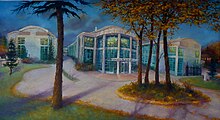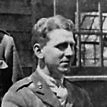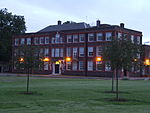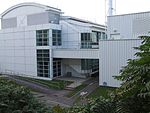National Physical Laboratory (United Kingdom)
 Painting of the laboratory by Lee Campbell, resident artist there in 2009 | |
| Established | 1900 (1900) |
|---|---|
| Research type | Applied Physics |
Field of research | Metrology |
| Director | Peter Thompson |
| Staff | 650[1] |
| Address | Hampton Road, Teddington, TW11 0LW, England |
| Location | 51°25′35″N 0°20′37″W / 51.42639°N 0.34361°W / 51.42639; -0.34361Coordinates: 51°25′35″N 0°20′37″W / 51.42639°N 0.34361°W / 51.42639; -0.34361 |
Operating agency | Department for Business, Innovation and Skills – National Measurement Office |
| Website | npl.co.uk |
The National Physical Laboratory (NPL) is the national measurement standards laboratory for the United Kingdom, based at Bushy Park in Teddington, London, England. It comes under the management of the Department for Business, Innovation and Skills.
Contents
1 History
2 Activities
3 Researchers
4 Research
4.1 Atomic clocks
4.2 Computing
4.3 Packet switching
5 Directors of NPL
6 See also
7 References
8 External links
History

The Electricity Division of the National Physical Laboratory in 1944
The National Physical Laboratory was established in 1900 at Bushy House "to bring scientific knowledge to bear practically upon our everyday industrial and commercial life".[2] It grew to fill a large selection of buildings on the Teddington site.[3] NPL procured a large state-of-the-art laboratory under a Private Finance Initiative contract in 1998. The construction, which was being undertaken by John Laing, and the maintenance of this new building, which was being undertaken by Serco, was transferred back to the DTI in 2004 after the private sector companies involved made losses of over £100m.[4]
The laboratory was initially run by the UK government, with members of staff being part of the civil service. Administration of the NPL was contracted out in 1995 under a Government Owned Contractor Operated model, with Serco winning the bid and all staff transferred to their employ. Under this regime, overhead costs halved, third party revenues grew by 16% per annum, and the number of peer-reviewed research papers published doubled.[5] It was decided in 2012 to change the operating model for NPL from 2014 onward to include academic partners and to establish a postgraduate teaching institute on site.[6] The date of the changeover was later postponed for up to a year.[7] The candidates for lead academic partner were the Universities of Edinburgh, Southampton, Strathclyde and Surrey[8] with an alliance of the Universities of Strathclyde and Surrey chosen as preferred partners.[9]
In January 2013 funding for a new £25m Advanced Metrology Laboratory was announced that will be built on the footprint of an existing unused building.[10][11]
The operation of the laboratory transferred back to Department for Business, Innovation and Skills ownership on 1 January 2015.[12]
Activities
The National Physical Laboratory is involved with new developments in metrology, such as researching metrology for, and standardising, nanotechnology.[13] It is mainly based at the Teddington site, but also has a site in Huddersfield for dimensional metrology[14] and an underwater acoustics facility at Wraysbury Reservoir.[15]
Researchers
- Notable researchers at NPL

Robert Watson-Watt

Louis Essen (right)
Researchers who have worked at NPL include:[16]D. W. Dye who did important work in developing the technology of quartz clocks. The inventor Sir Barnes Wallis did early development work there on the "Bouncing Bomb" used in the "Dam Busters" wartime raids.[17]H.J. Gough, one of the pioneers of research into metal fatigue, worked at NPL for 19 years from 1914 to 1938. Sydney Goldstein and Sir James Lighthill worked in NPL's aerodynamics division during World War II researching boundary layer theory and supersonic aerodynamics respectively. Dr Clifford Hodge also worked there and was engaged in research on semiconductors. Others who have spent time at NPL include Robert Watson-Watt, generally considered the inventor of radar, Oswald Kubaschewski, the father of computational materials thermodynamics and the numerical analyst James Wilkinson.[18]
Research
NPL research has contributed to physical science, materials science, computing, and bioscience. Applications have been found in ship design, aircraft development, radar, computer networking and global positioning.[19]
Atomic clocks
The first accurate atomic clock, a caesium standard based on a certain transition of the caesium-133 atom, was built by Louis Essen and Jack Parry in 1955 at NPL.[20][21] Calibration of the caesium standard atomic clock was carried out by the use of the astronomical time scale ephemeris time (ET).[22] This led to the internationally agreed definition of the latest SI second being based on atomic time.[23]
Computing
NPL has undertaken computer research since the mid-1940s.[24] From 1945, Alan Turing led the design of the Automatic Computing Engine (ACE) computer. The ACE project was overambitious and floundered, leading to Turing's departure.[25]Donald Davies took the project over and concentrated on delivering the less ambitious Pilot ACE computer, which first worked in May 1950. Among those who worked on the project was American computer pioneer Harry Huskey. A commercial spin-off, DEUCE was manufactured by English Electric Computers and became one of the best-selling machines of the 1950s.[25]
Packet switching
Beginning in the mid-1960s, Donald Davies and his team at the NPL pioneered packet switching, now the dominant basis for data communications in computer networks worldwide. Davies designed and proposed a national data network based on packet switching in his 1965 Proposal for the Development of a National Communications Service for On-line Data Processing.[26] Subsequently, the NPL team (Davies, Derek Barber, Roger Scantlebury, Peter Wilkinson, Keith Bartlett, and Brian Aldous)[27] developed the concept into a local area network which operated from 1969 to 1986, and carried out work to analyse and simulate the performance of packet switching networks. Their research and practice influenced the ARPANET in the United States, the forerunner of the Internet, and other researchers in the UK and Europe.[28][29][30][31]
Directors of NPL
- Directors of NPL

E. V. Appleton

W. L. Bragg

C. G. Darwin

Peter Clapham
Directors of NPL include a number of notable individuals.[32]
Sir Richard Tetley Glazebrook, 1900–1919- Sir Joseph Ernest Petavel, 1919–1936
- Sir Frank Edward Smith, 1936–1937 (acting)
Lawrence Bragg, 1937–1938- Sir Charles Galton Darwin, 1938–1949
- Sir Edward Victor Appleton, 1941 (acting)
Sir Edward Crisp Bullard, 1948–1955- Dr Reginald Leslie Smith-Rose, 1955–1956 (acting)
- Sir Gordon Brims Black McIvor Sutherland, 1956–1964
- Dr John Vernon Dunworth, 1964–1977
- Dr Paul Dean, 1977–1990
- Dr Peter Clapham, 1990–1995
Managing Directors
- Dr John Rae, 1995–2000
- Dr Bob McGuiness, 2000–2005
Steve McQuillan, 2005–2008- Dr Martyn Sené, 2008–2009, 2015 (acting)
- Dr Brian Bowsher, 2009–2015
Chief Executive Officers
- Dr Peter Thompson, 2015–present[33]
- NPL buildings
Bushy House
The Darwin building
Part of the new building

NPL's main entrance on Hampton Road

Ground floor plan of Bushy House in 1901/1902

Basement plan of Bushy House in 1901/1902
See also
- List of UK government scientific research institutes
References
^ Annual Review 2013
^ "history" (PDF). National Physical Laboratory. Retrieved 6 May 2018..mw-parser-output cite.citation{font-style:inherit}.mw-parser-output q{quotes:"""""""'""'"}.mw-parser-output code.cs1-code{color:inherit;background:inherit;border:inherit;padding:inherit}.mw-parser-output .cs1-lock-free a{background:url("//upload.wikimedia.org/wikipedia/commons/thumb/6/65/Lock-green.svg/9px-Lock-green.svg.png")no-repeat;background-position:right .1em center}.mw-parser-output .cs1-lock-limited a,.mw-parser-output .cs1-lock-registration a{background:url("//upload.wikimedia.org/wikipedia/commons/thumb/d/d6/Lock-gray-alt-2.svg/9px-Lock-gray-alt-2.svg.png")no-repeat;background-position:right .1em center}.mw-parser-output .cs1-lock-subscription a{background:url("//upload.wikimedia.org/wikipedia/commons/thumb/a/aa/Lock-red-alt-2.svg/9px-Lock-red-alt-2.svg.png")no-repeat;background-position:right .1em center}.mw-parser-output .cs1-subscription,.mw-parser-output .cs1-registration{color:#555}.mw-parser-output .cs1-subscription span,.mw-parser-output .cs1-registration span{border-bottom:1px dotted;cursor:help}.mw-parser-output .cs1-hidden-error{display:none;font-size:100%}.mw-parser-output .cs1-visible-error{font-size:100%}.mw-parser-output .cs1-subscription,.mw-parser-output .cs1-registration,.mw-parser-output .cs1-format{font-size:95%}.mw-parser-output .cs1-kern-left,.mw-parser-output .cs1-kern-wl-left{padding-left:0.2em}.mw-parser-output .cs1-kern-right,.mw-parser-output .cs1-kern-wl-right{padding-right:0.2em}
^ "Development of the NPL Site 1900-1970.pdf" (PDF). 2013. Retrieved 23 December 2013.
^ "The Termination of the PFI Contract for the National Physical Laboratory |National Audit Office". nao.org.uk. 2013. Retrieved 23 December 2013.
^ Labs under the microscope – Ethos. Ethosjournal.com (2 February 2012). Retrieved on 12 April 2014.
^ "Microsoft Word - Briefing document 26 March 2013_final - establishing-a-new-partnership-for-the-npl-briefing-note.pdf" (PDF). 2013. Retrieved 23 December 2013.
^ "NPL contract with Serco extended : News : News + Events : National Physical Laboratory". npl.co.uk. 2014. Retrieved 3 April 2014.
^ "Future operation of the National Physical Laboratory | National Measurement System | BIS". bis.gov.uk. 2013. Retrieved 23 December 2013.
^ "Press Release – Universities of Surrey and Strathclyde selected as strategic partners in the future operation of the National Physical Laboratory" (PDF). NPL. 10 July 2014. p. 5. Retrieved 11 July 2014.
^ Willetts, David (2013). "Announcement of £25 million Advanced Metrology Laboratory at NPL | News | BIS". bis.gov.uk. Retrieved 23 December 2013.
^ "National Physical Laboratory, Hampton Road, Teddington, Middlesex, United Kingdom, TW11 0LW - aml-letter-july2013.pdf" (PDF). 2013. Retrieved 23 December 2013.
^ Future operation of the National Physical Laboratory (NPL). Retrieved 24 March 2015
^ Minelli, C. & Clifford, C.A. (2012). "The role of metrology and the UK National Physical Laboratory in Nanotechnology". Nanotechnology Perceptions. 8: 59-75.CS1 maint: Multiple names: authors list (link)
^ "Dimensional Specialist Inspection and Measurement Services : Measurement Services : Commercial Services : National Physical Laboratory". npl.co.uk. 2013. Retrieved 23 December 2013.
^ "Calibration and characterisation of sonar transducers and systems : Products & Services : Underwater Acoustics : Acoustics : Science + Technology : National Physical Laboratory". npl.co.uk. 2013. Retrieved 23 December 2013.
^ "Notable Individuals". National Physical Laboratory. Retrieved 2017-10-17.
^ Biographical Memoirs of Fellows of the Royal Society
^ "James (Jim) Hardy Wilkinson". IEEE Computer Society. Retrieved 6 May 2018.
^ "Research". National Physical Laboratory. Retrieved 2017-10-17.
^
Essen, L.; Parry, J. V. L. (1955). "An Atomic Standard of Frequency and Time Interval: A Cæsium Resonator". Nature. 176 (4476): 280–282. Bibcode:1955Natur.176..280E. doi:10.1038/176280a0.
^ "60 years of the Atomic Clock". National Physical Laboratory. Retrieved 2017-10-17.
^
W. Markowitz; R.G. Hall; L. Essen; J.V.L. Parry (1958). "Frequency of cesium in terms of ephemeris time". Physical Review Letters. 1 (3): 105–107. Bibcode:1958PhRvL...1..105M. doi:10.1103/PhysRevLett.1.105.
^ "What Is International Atomic Time (TAI)?". Time and Date. Retrieved 6 May 2018.
^ "History of NPL Computing". National Physical Laboratory. Retrieved 2017-10-17.
^ ab Cambell-Kelly, Martin (Autumn 2008). "Pioneer Profiles: Donald Davies". Computer Resurrection (44). ISSN 0958-7403.
^ Davies, D. W. (1966), Proposal for a Digital Communication Network (PDF), National Physical Laboratory
^ "Technology of the Internet". The National Museum of Computing. Retrieved 3 October 2017.
^ Gillies, James; Cailliau, Robert (2000). How the Web was Born: The Story of the World Wide Web. Oxford University Press. p. 25. ISBN 0192862073.
^ Isaacson, Walter (2014). The Innovators: How a Group of Hackers, Geniuses, and Geeks Created the Digital Revolution. Simon & Schuster. p. 237. ISBN 9781476708690.
^ C. Hempstead; W. Worthington (2005). Encyclopedia of 20th-Century Technology. Routledge.
^ Stewart, Bill (7 January 2000). "UK National Physical Laboratory (NPL) & Donald Davies". Living Internet. Retrieved 12 May 2008.
^ "Directors". National Physical Laboratory. Retrieved 2017-10-17.
^ "New CEO for National Physical Laboratory : News : News + Events : National Physical Laboratory". npl.co.uk. 2015. Retrieved 1 September 2015.
External links
| Wikimedia Commons has media related to National Physical Laboratory (United Kingdom). |
- NPL Website
- NPL Video Podcast
- Second Health in Second Life
- NMS Home Page
- NPL YouTube Channel
- NPL Sports and Social Club
Ethos Journal profile of the National Physical Laboratory












